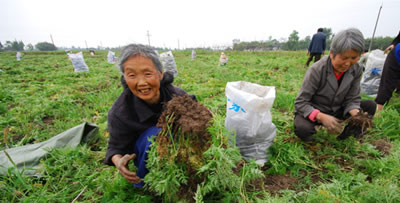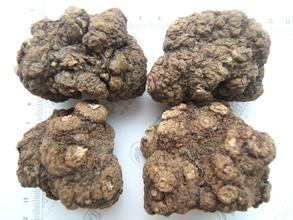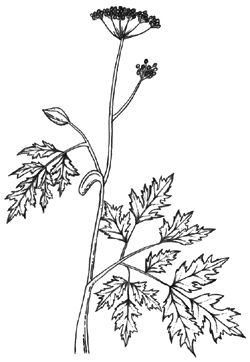 Ligusticum
chuanxiong, L. striatum. L.
wallichii ,
川
芎 Chuān
xiōng Szechuan lovage root, Cnidium
Ligusticum
chuanxiong, L. striatum. L.
wallichii ,
川
芎 Chuān
xiōng Szechuan lovage root, Cnidium
Ligusticum sinense is also called Chinese Lovage. The common name Lovage also describes the Eastern herb; Levisticum officinale
 FLAVOR:
Pungent, acrid, Slightly bitter. CHANNELS: Liver, Gall bladder
FLAVOR:
Pungent, acrid, Slightly bitter. CHANNELS: Liver, Gall bladderFUNCTION
GROUP: Regulate Blood and removing stasis
1. Activate blood, promote flow of Qi. Relieve pain.[1,2]
2. Disperse Wind.[2] Expel Wind.[1] Clears Wind and nourishes the Blood.[1]
INDICATIONS
1. Headache[1,2]
- Due to Wind Cold: Little sweating. Acrid flavor has rising effect.[2]
- Due to Wind Damp: Especially migraine on one side.[2]
- Due to Blood deficiency stasis: Migraine or post partum.[2]
- Due to Liver Qi stagnation: P- choppy.[2]
2. Upper body pain: chronic pain in chest and diaphragm, angina and headache.[2]
3. Dysmenorrhea, late periods, scanty periods, amenorrhea.[2] Abdominal pain due to suppression of period.[1]
4. Rheumatic pain.[1] Wind Damp of tendons: numbness, pain, paralysis.[1]
5. Fall injuries.[1]
CONTRAINDICATIONS: Overuse. Excessive menses, bleeding. Yin deficiency.[2]
PATENT COMBINATIONS
PREPARATIONS: Dried rhizomes 3-9 g.[1,2] Higher dose of 9 g for menstual disorders.[2] The rhizomes are harvested in late May (China).


 References
ReferencesInner Path can not take any responsibility for any adverse effects from the use of plants. Always seek advice from a professional before using a plant medicinally.
Research
Anti-inflammatory ligustilides from Ligusticum chuanxiong Hort.
Huang J, Lu XQ, Zhang C, Lu J, Li GY, Lin RC, Wang JH.
Abstract
Four new ligustilides chuanxiongnolide R1 (1), chuanxiongnolide R2 (2), chuanxiongdiolide R1 (3) and chuanxiongdiolide R2 (4) together with eight known derivatives (5-12) were isolated from the root of Ligusticum chuanxiong Hort. Their structures were elucidated by HR-ESI-MS, UV, IR, 1D and 2D NMR (HSQC, HMBC, (1)H-(1)H COSY, NOESY) methods. The absolute configurations were confirmed via the circular dichroism (CD) spectrum. The anti-inflammatory assay in LPS-triggered RAW 264.7 macrophages was carried out on the twelve compounds. 1, 3, 5 and 6 showed significant inhibitory effects against LPS-induced NO production.
PMID: 23973655 DOI: 10.1016/j.fitote.2013.08.013
Fitoterapia. 2013 Dec;91:21-7. doi: 10.1016/j.fitote.2013.08.013. Epub 2013 Aug 23. ncbi.nlm.nih.gov
Ligusticum chuanxiong prevents ovariectomy-induced liver and vascular damage in rats.
Li CM, Wu JH, Yang RF, Dong XL, He ZY, Tian XL, Guo DJ, Wong MS, Qiu TQ, Chan SW.
Abstract
Post-menopause, there is an increase in body weight, visceral adiposity, and risk of developing non-alcoholic fatty liver disease (NAFLD), which leads to various cardiovascular diseases (CVDs). Some natural products have proven useful for counteracting the detrimental effects of menopause. The rhizome of Ligusticum chuanxiong Hort. (LC) is a well-known medicinal herb widely used in Chinese communities for the treatment of CVDs. The hepatic and vascular protective effects of LC ethanolic extract under postmenopausal conditions were investigated on ovariectomized (OVX) rats supplemented with or without LC ethanolic extract (600 mg/kg body weight/day, p.o.) or 17β-estradiol (1 mg/kg body weight/day, p.o.) for 12 weeks. The current findings demonstrated that consumption of LC ethanolic extract could reduce the body weight gain, improve serum lipid profile (lowering low density lipoprotein cholesterol but raising high density lipoprotein cholesterol), combat NAFLD, and protect vascular endothelium in the OVX rats. The beneficial effects of LC may be associated with its antioxidant or vasorelaxant compounds, which enhance the levels of hepatic antioxidant enzymes and up-regulate endothelial nitric oxide synthase mRNA expression, respectively. Taken together, LC may be a promising natural supplement for postmenopausal women to prevent NAFLD and CVDs.
PMID: 23895155 DOI: 10.1142/S0192415X13500560
Am J Chin Med. 2013;41(4):831-48. doi: 10.1142/S0192415X13500560. ncbi.nlm.nih.gov
Ethanolic extract of rhizome of Ligusticum chuanxiong Hort. (chuanxiong) enhances endothelium-dependent vascular reactivity in ovariectomized rats fed with high-fat diet.
Li CM, Guo YQ, Dong XL, Li H, Wang B, Wu JH, Wong MS, Chan SW.
Abstract
The rhizome of Ligusticum chuanxiong Hort. (LC), also known as chuanxiong, is a very common herb widely used to treat cardiovascular and cerebrovascular diseases. It is also used as a major ingredient in soups for regular consumption to promote good health. To study the protective effect of LC ethanolic extract (LCEE, 600 mg per kg per day, p.o.) on the integrity of the vascular system, ovariectomized (OVX) rats were fed with a high-fat diet (HFD) plus LCEE for 12 weeks. The animal model was used to mimic the dyslipidemic condition seen in postmenopausal women. LCEE was found significantly to reduce the body weight gain, improve serum lipid profiles (by lowering total cholesterol and low density lipoprotein cholesterol but raising high density lipoprotein cholesterol) and protect vascular endothelium in the HFD-fed OVX rats. It is postulated that LCEE could exert its vascular protective effect through multiple targets by (1) improving serum lipid profiles to reduce the detrimental effects of cholesterol; (2) reducing the ROS level in the body via enhancing the hepatic anti-oxidative activity or antioxidant level to scavenge the reactive oxygen species generated in the postmenopausal hypercholesterolemic condition; (3) stimulating eNOS-derived nitric oxide production; (4) counteracting the up-regulation of inflammatory cytokine (TNF-α, VCAM-1 and ICAM-1) expressions so as to reduce endothelium damage.
PMID: 25110278 DOI: 10.1039/c4fo00211c Food Funct. 2014 Oct;5(10):2475-85. doi: 10.1039/c4fo00211c. Epub 2014 Aug 11. ncbi.nlm.nih.gov